25.05.2022 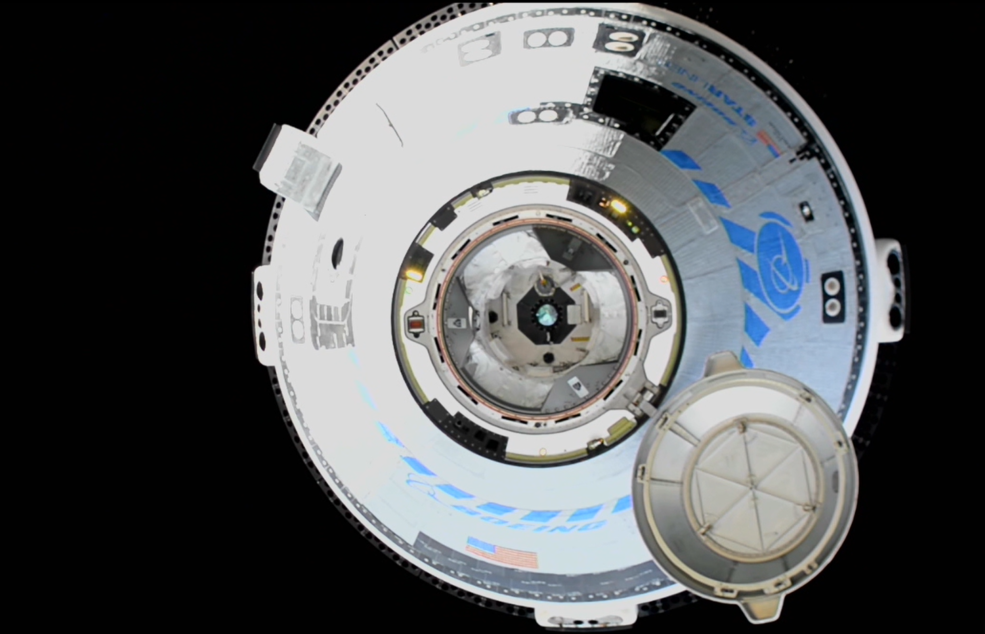
NASA will provide live coverage of the upcoming return activities for the agency’s Boeing Orbital Flight Test-2 (OFT-2). As part of the uncrewed flight test, Boeing’s CST-100 Starliner spacecraft will depart from the International Space Station for a landing in the western United States.
The spacecraft is scheduled to autonomously undock from the space station to begin the journey home at 2:36 p.m. EDT Wednesday, May 25. NASA and Boeing are targeting 6:49 p.m. for the landing and conclusion of OFT-2, wrapping up a six-day mission testing the end-to-end capabilities of the Starliner system.
The return and related activities will air live on NASA Television, the NASA app, and the agency’s website.
In advance of Starliner’s return, commercial crew astronauts at the space station will speak with NASA leadership and make farewell remarks prior to closing the hatch to the uncrewed spacecraft.
Teams are targeting White Sands Space Harbor at the U.S. Army’s White Sands Missile Range in New Mexico as the primary landing site, with a backup White Sands opportunity Friday, May 27. The spacecraft will return with more than 600 pounds of cargo, including Nitrogen Oxygen Recharge System reusable tanks that provide breathable air to station crew members. The tanks will be refilled on Earth and sent back to station on a future flight.
NASA’s Boeing OFT-2 return coverage on NASA TV is as follows and all times are subject to change based on mission operations (all times are Eastern):
Tuesday, May 24
12:20 p.m. – NASA Administrator event on Starliner’s flight test with commercial crew astronauts at station
12:55 p.m. – Starliner farewell ceremony
1:30 p.m. – Hatch closure TV coverage begins for 1:55 p.m. hatch closing
Wednesday, May 25
2 p.m. – TV coverage begins for the 2:36 p.m. undocking. NASA will break coverage after the spacecraft exits joint operations with the space station.
5:45 p.m. – Coverage begins for 6:05 p.m. deorbit burn and 6:49 p.m. landing in the western United States.
9 p.m. – Return to Earth news conference on NASA TV from NASA’s Johnson Space Center in Houston:
- Steve Stich, manager, NASA’s Commercial Crew Program
- Joel Montalbano, manager, NASA’s International Space Station Program
- Suni Williams, NASA astronaut
- Mark Nappi, vice president and program manager, Boeing
Media wishing to participate in the briefings in person must request credentials from the Johnson newsroom at: 281-483-5111 or jsccommu@mail.nasa.gov no later than noon Tuesday, May 24. Media interested in participating by phone must contact the Johnson newsroom by noon Wednesday, May 25. Those wanting to submit a question on social media may do so using #askNASA.
Learn more about space station activities by following @space_station, and @ISS_Research on Twitter, as well as the ISS Facebook and ISS Instagram accounts and the space station blog.
Quelle: NASA
----
Update: 26.05.2022
Starliner spacecraft cleared for undocking and re-entry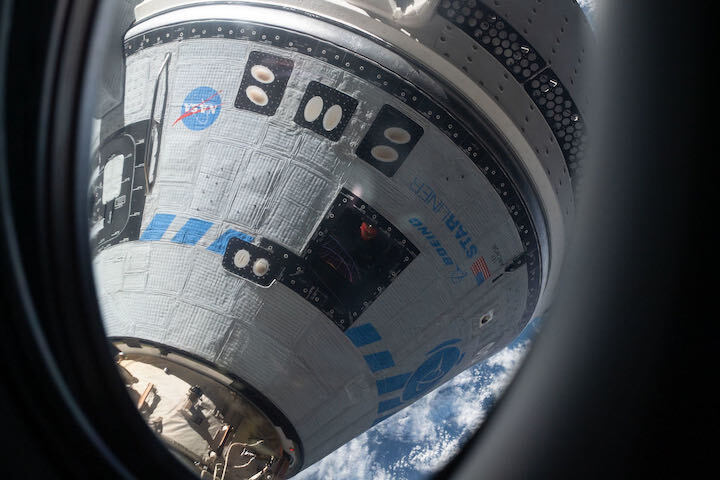
Astronauts on the International Space Station closed the hatch to Boeing’s Starliner spacecraft Tuesday, and ground teams used the lab’s robotic arm to inspect the capsule’s heat shield to clear the test vehicle for undocking Wednesday and return to Earth for a late afternoon landing in New Mexico.
The Boeing-owned spacecraft launched last Thursday and docked at the space station Friday night, reaching the orbiting research complex for the first time after officials aborted a test flight in 2019. The unpiloted demonstration mission is set to conclude Wednesday with an automated departure from the space station, followed a few hours later by a parachute-assisted, airbag cushioned landing at White Sands Space Harbor.
NASA astronauts Kjell Lindgren and Bob Hines closed the forward hatch to the Starliner spacecraft at 3 p.m. EDT (1900 GMT) Tuesday. Hines became the first person to enter a Starliner spacecraft in orbit Saturday, when the station crew opened the hatch and began three days of inspections and checkouts inside the capsule’s crew cabin.
Lindgren and Hines, who arrived at the station on a SpaceX Dragon capsule last month, performed several tests inside the Starliner capsule during its docked stay at the space station. They performed communications checks inside the Starliner spacecraft, unpacked about 500 pounds of cargo, then replace it with about 600 pounds of cargo for return to Earth.
The Starliner is scheduled to undock from the station at 2:36 p.m. EDT (1836 GMT) Wednesday, then back away to a safe distance from the complex before a 58-second braking burn at 6:05 p.m. EDT (2205 GMT) to drop out of orbit.
The crew module, designed for reuse, will jettison its disposable service module at 6:08 p.m. EDT (2208 GMT). The service module houses the ship’s abort engines, solar panels, radiators and other equipment.
The service module will burn up during re-entry over the Pacific Ocean, while the Starliner crew module — containing an instrumented test dummy nicknamed “Rosie” — will orient itself using 12 control thrusters to point its blunt end forward to face a flow of super-heated air as it plunges into the atmosphere.
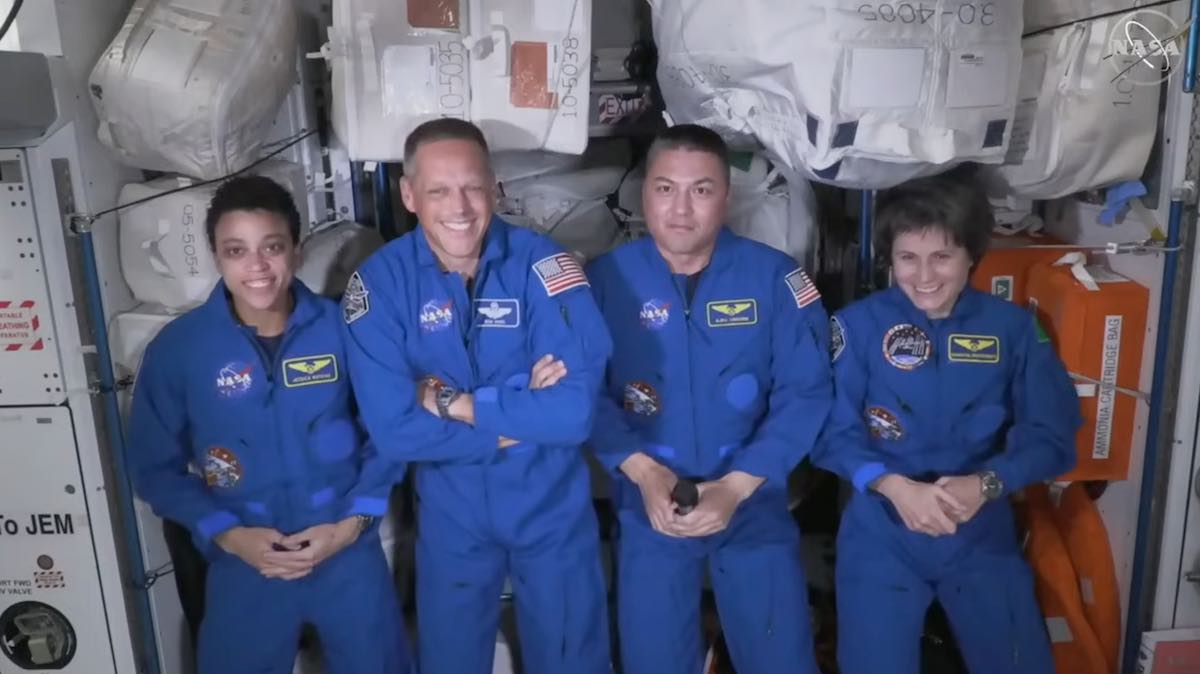
Traveling at 25 times the speed of sound, the 15-foot-wide (4.6-meter) Starliner capsule will encounter the first discernible traces of the atmosphere at 6:33 p.m. EDT (4:33 p.m. MDT; 2233 GMT). Temperatures outside the capsule will reach as hot as 3,000 degrees Fahrenheit (1,650 degrees Celsius).
An ablative base heat shield, ceramic tiles and thermal blankets will protect the capsule as it heads for White Sands.
The human-rated spaceship will fly over Mexico, passing just west of El Paso before triggering its parachute deployment sequence at an altitude of around 30,000 feet (9 kilometers).
The Starliner will jettison its upper heat shield and deploy a pair of drogue parachutes. Then mortars will fire and pilot chutes will pull three main parachutes from their bags at 6:45 p.m. EDT (4:45 p.m. MDT; 2245 GMT). Less than a minute later, the capsule will release its bottom heat shield, allowing airbags to inflate at around 3,000 feet (900 meters).
Touchdown is scheduled for 6:49 p.m. EDT (4:49 p.m. MDT; 2249 GMT) at White Sands Space Harbor, part of the U.S. Army White Sands Missile Range. The first Starliner test flight, which was cut short by software problems in 2019, successfully landed at White Sands.
The facility was used by NASA in 1982 for the landing of the space shuttle Columbia in 1982. Columbia touched down on an unpaved landing strip at White Sands to conclude NASA’s third space shuttle mission.
Boeing’s Starliner is the first U.S. crew-rated capsule designed to return from orbit for a landing on the ground. Russia’s Soyuz capsule is also designed for a ground landing, but SpaceX’s Dragon spacecraft and NASA’s Orion deep space crew capsule — like the Apollo command module from the 1960s and 1970s — splash down in the ocean at the end of their missions.
Forecasters predict favorable weather Wednesday for landing of the Starliner spacecraft at White Sands. Boeing’s backup landing site for this mission is Willcox Playa in Arizona. The Starliner program has also surveyed potential landing sites at Dugway Proving Ground in Utah and Edwards Air Force Base in California, in addition to two possible landing zones at White Sands.
The OFT-2 mission is a precursor before NASA clears astronauts to fly on the next Starliner mission to the International Space Station. After landing, Boeing will transport the Starliner capsule back to NASA’s Kennedy Space Center for refurbishment and use on a future crew mission. Quelle: SN ----
Update:
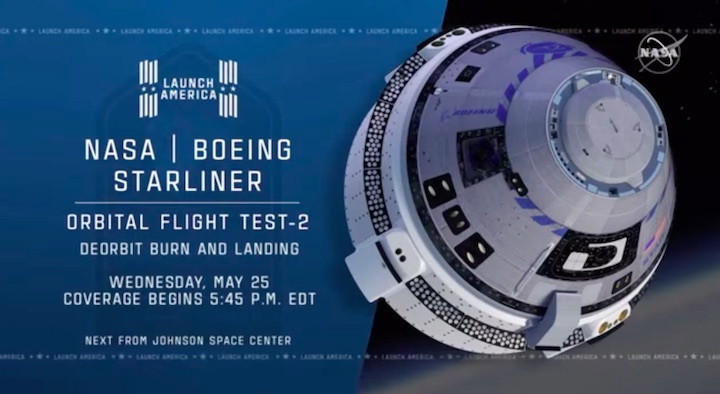
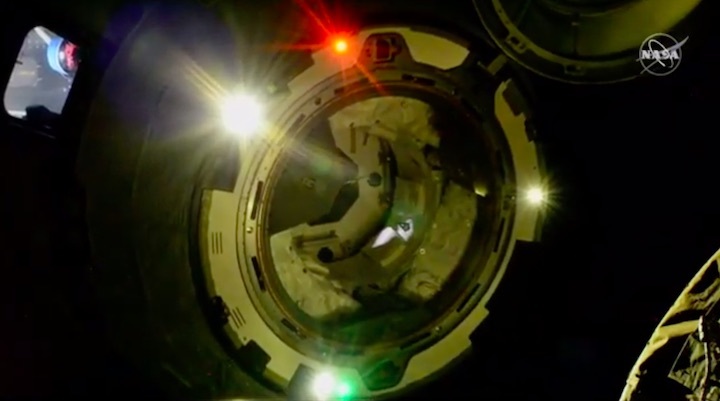
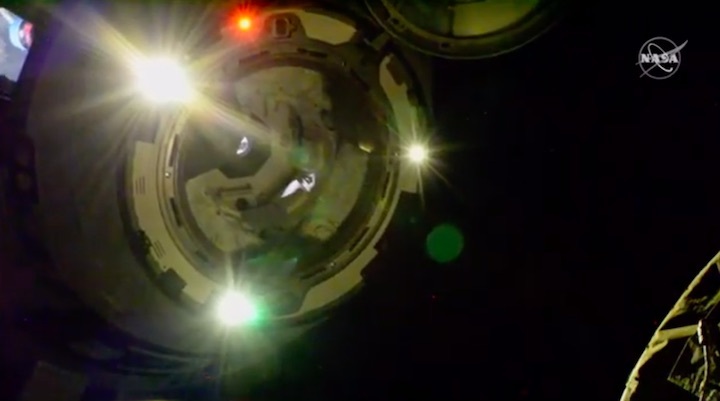
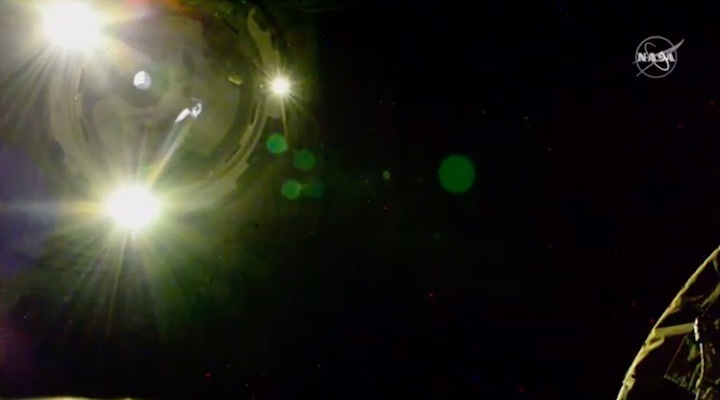
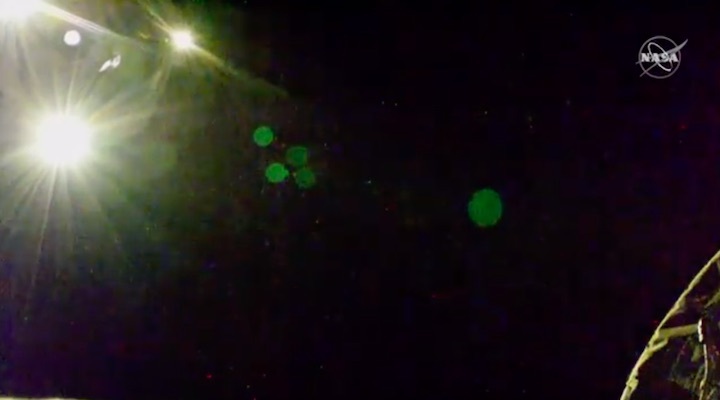
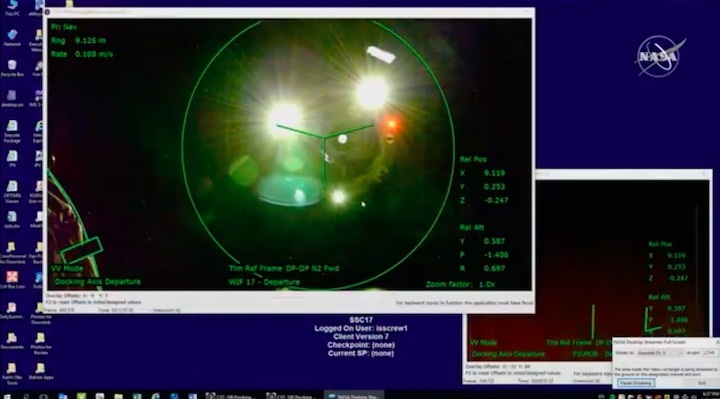

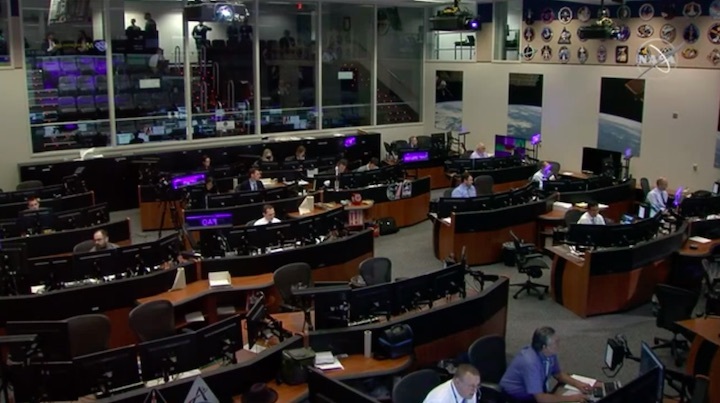
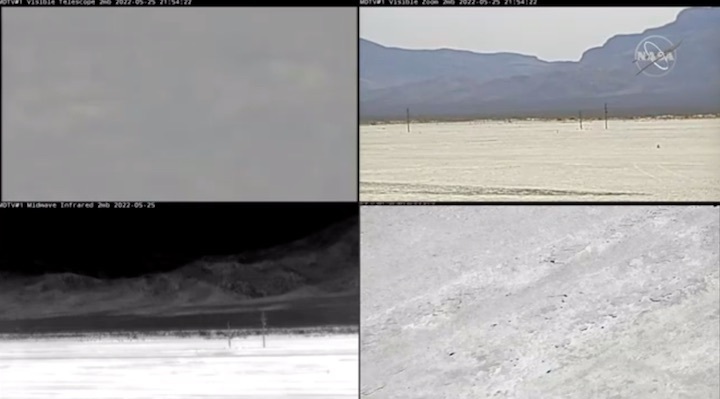
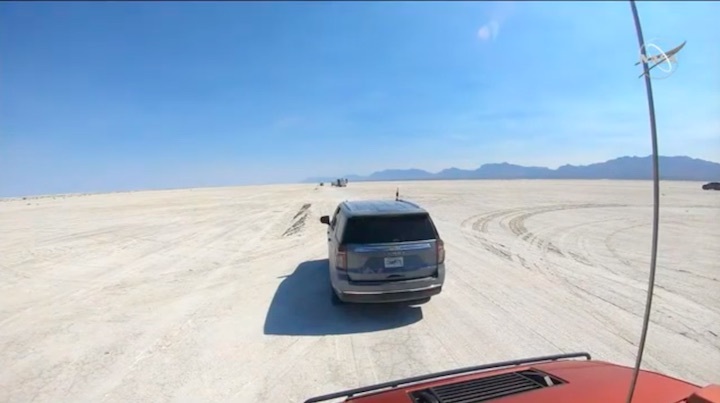
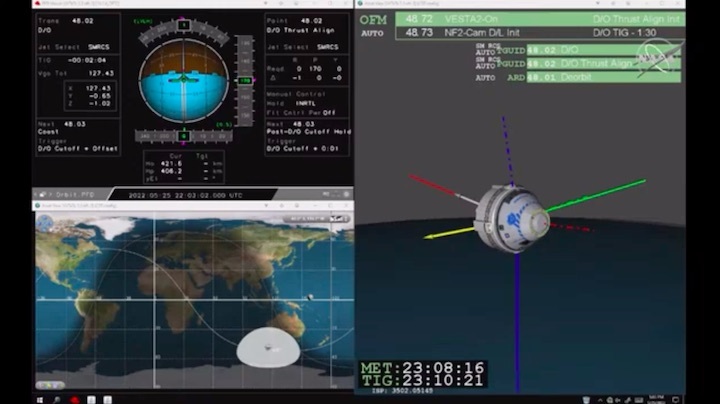
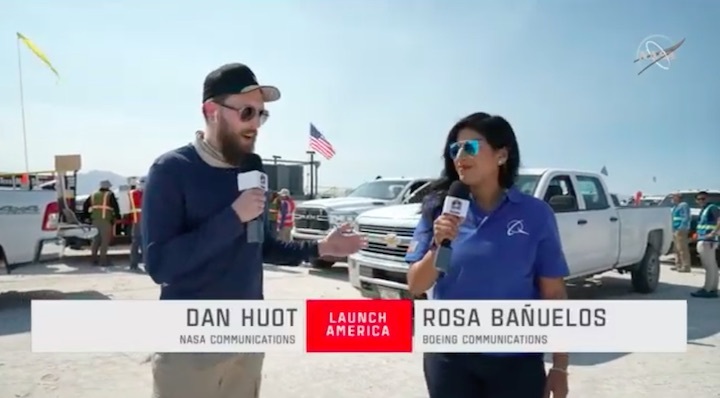
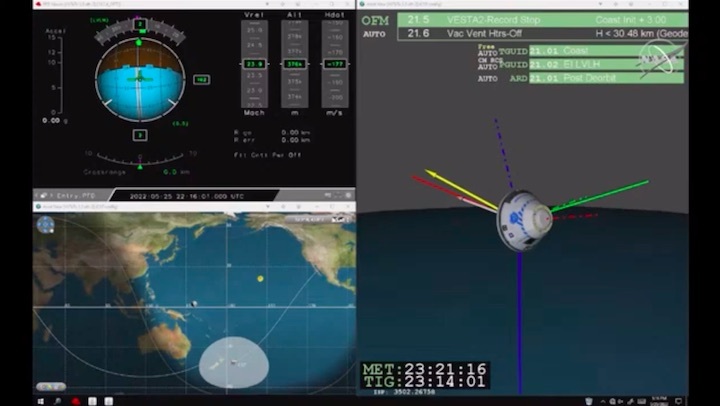
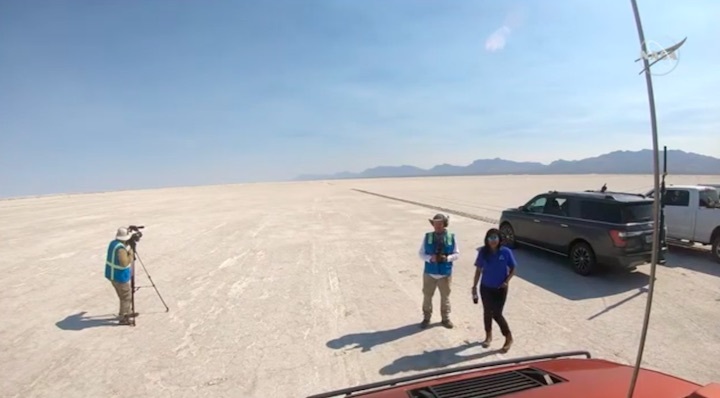
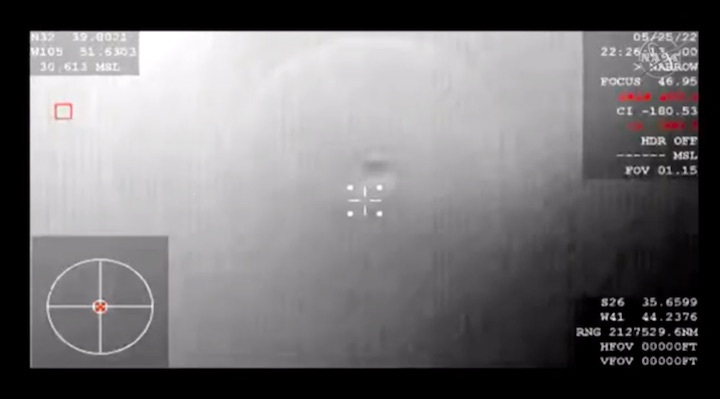
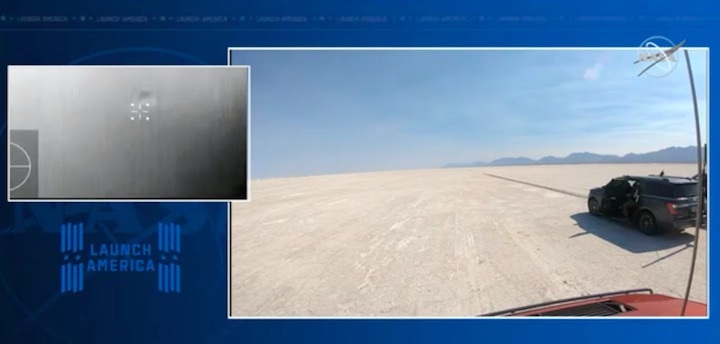
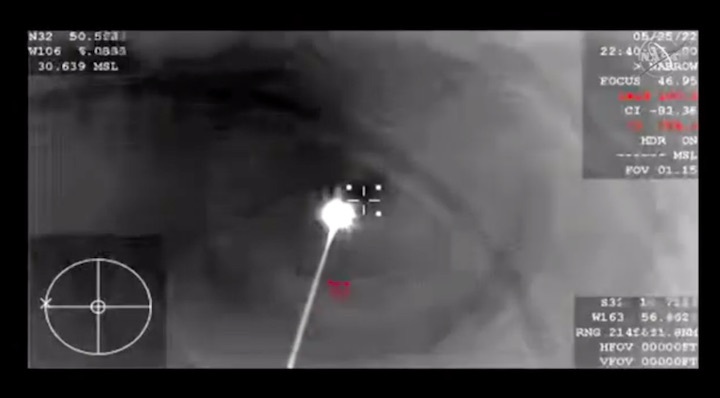
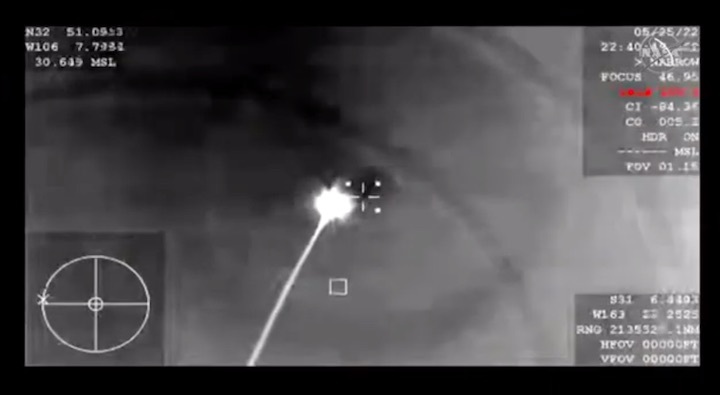
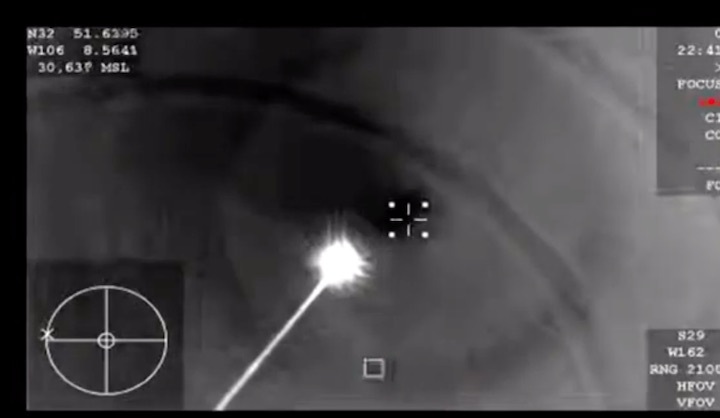
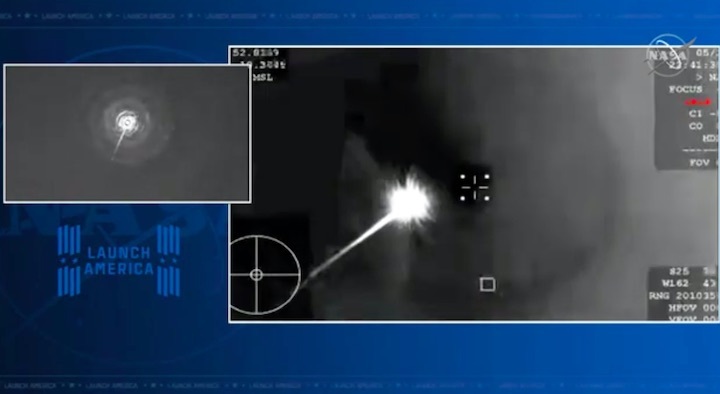
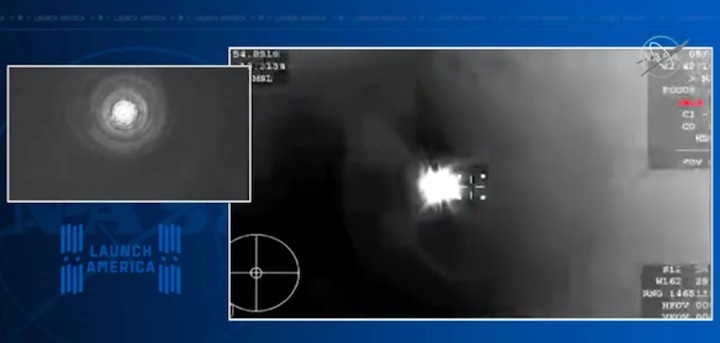
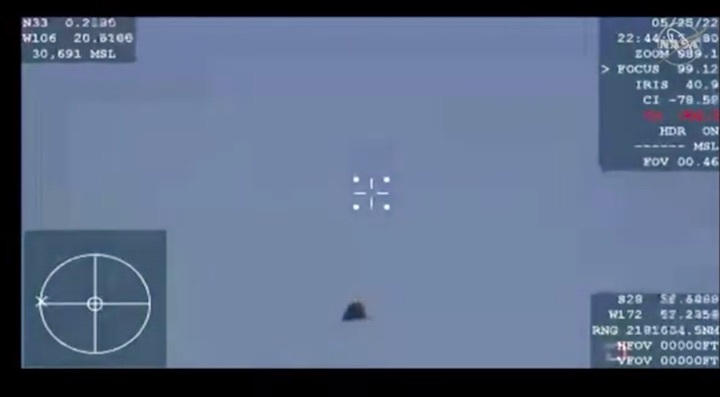
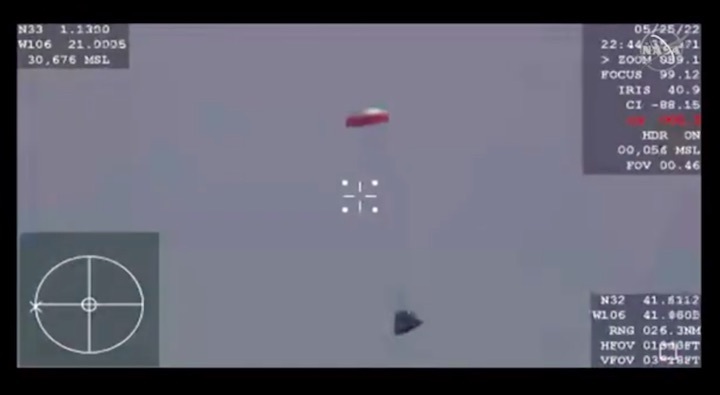
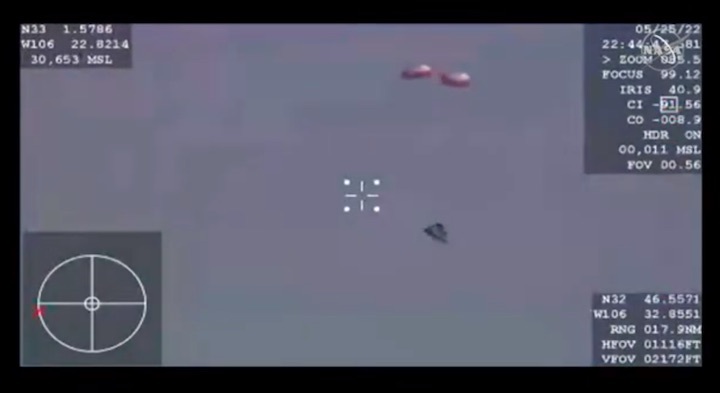
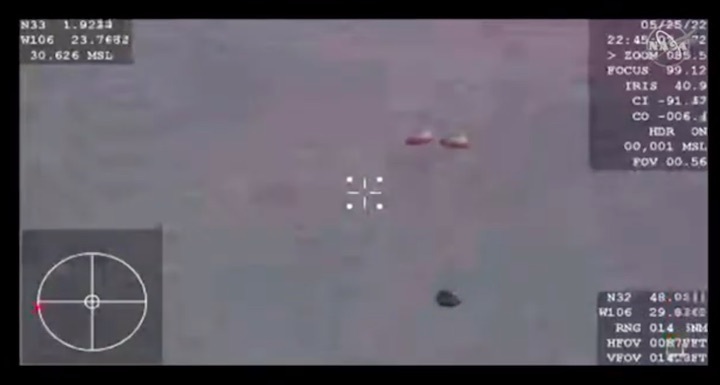
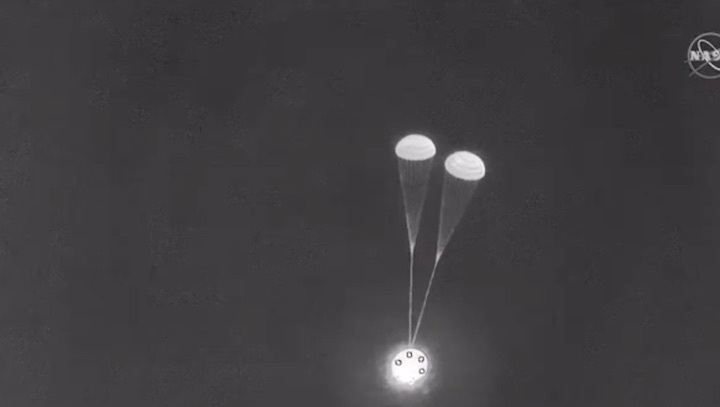
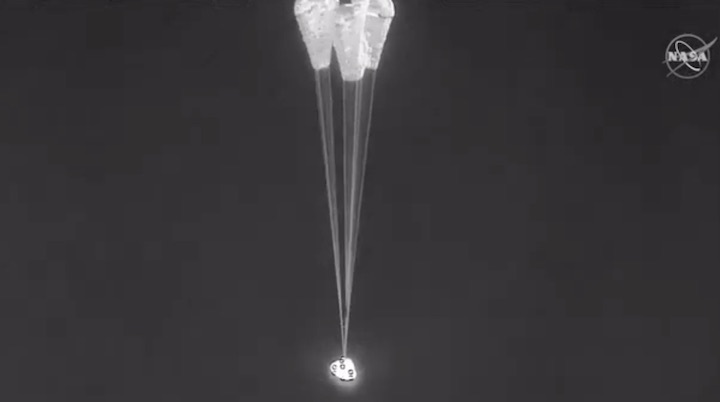
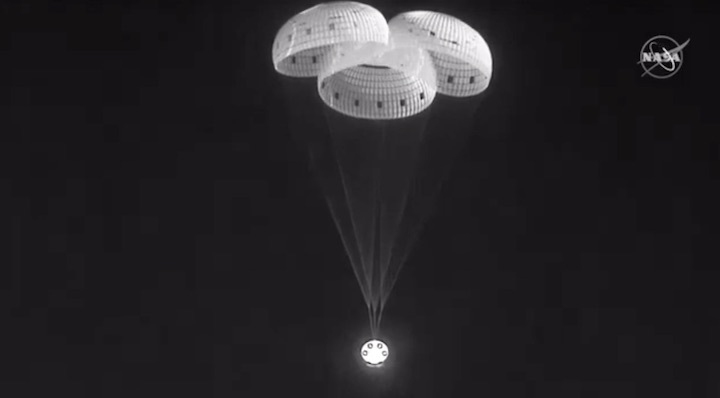
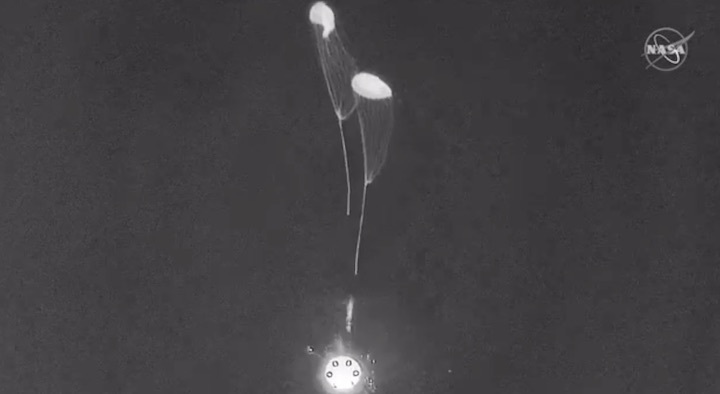
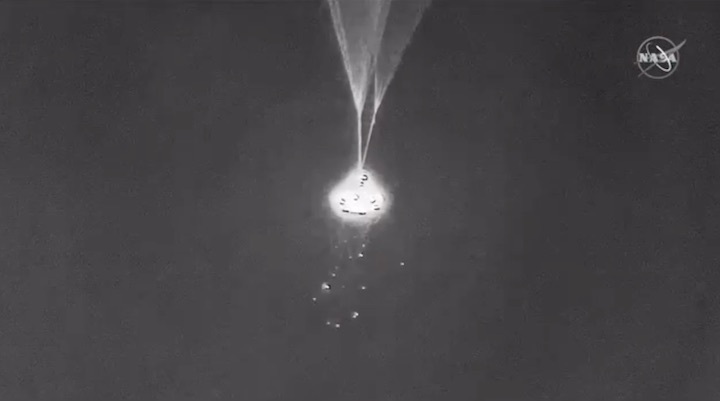
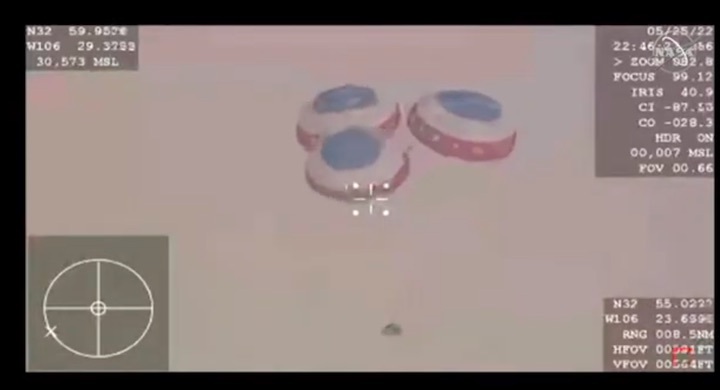
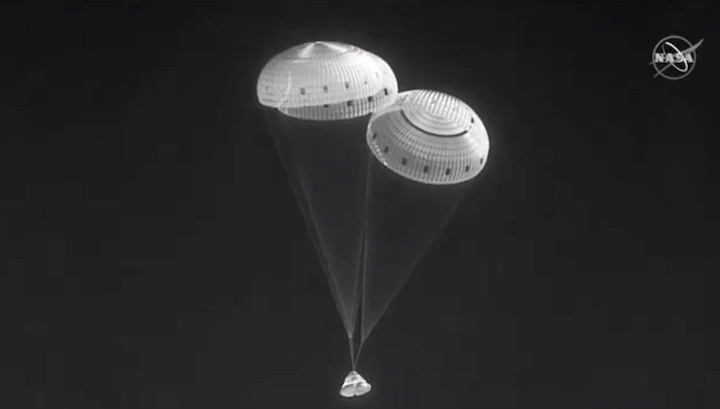
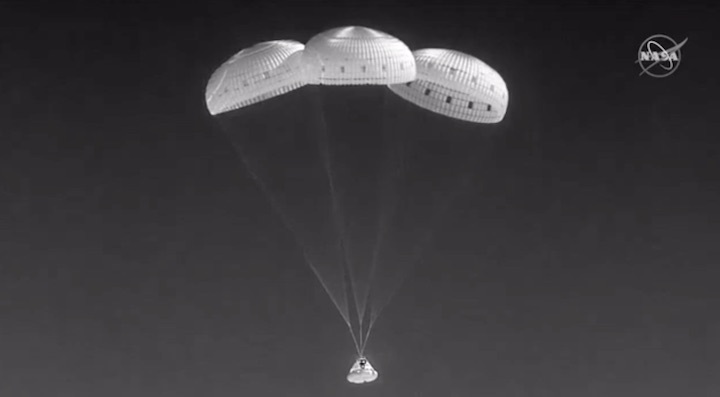
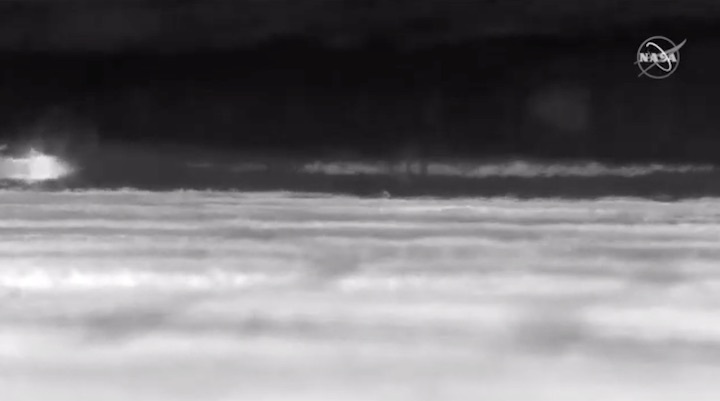
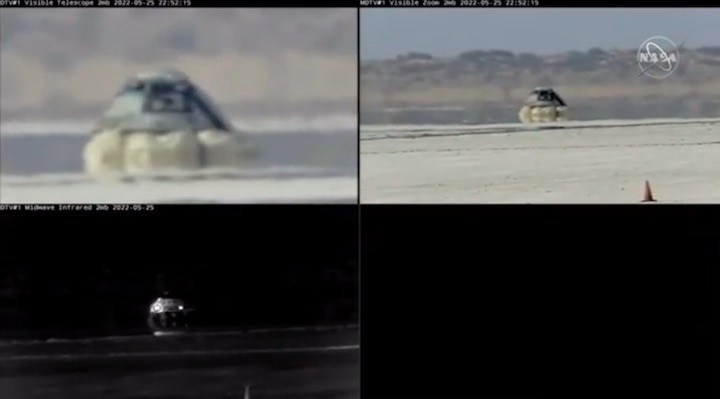
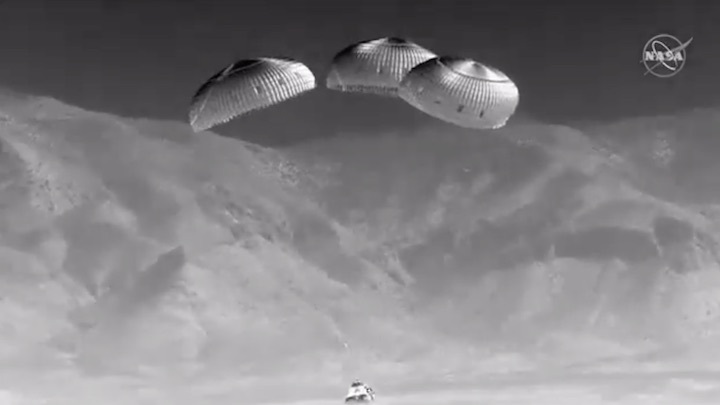
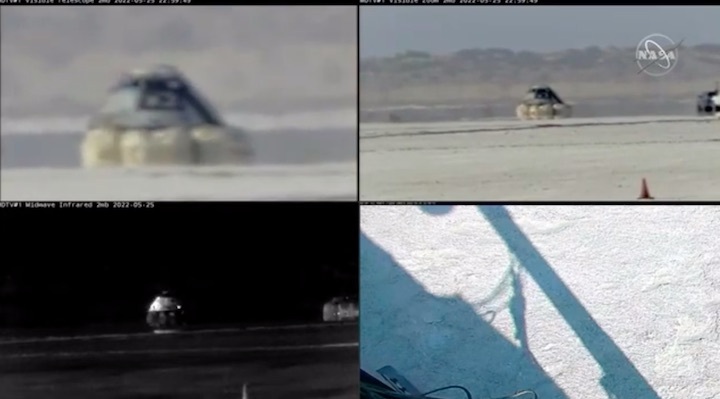
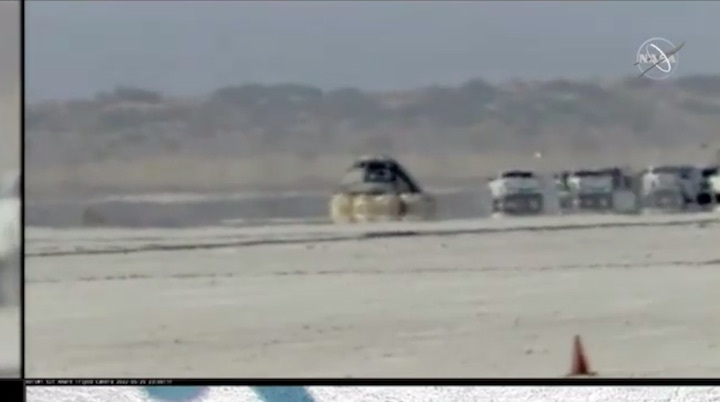

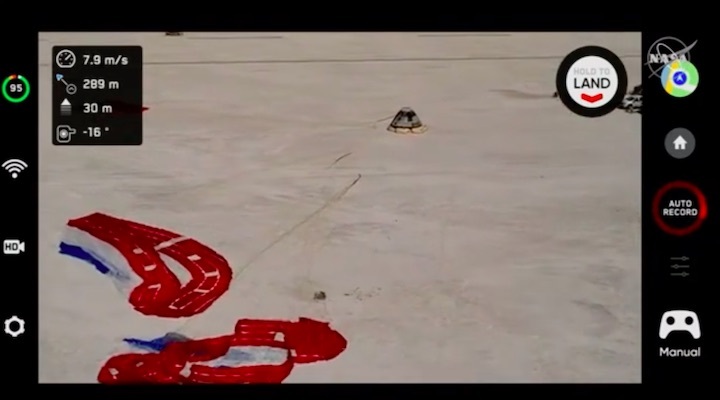
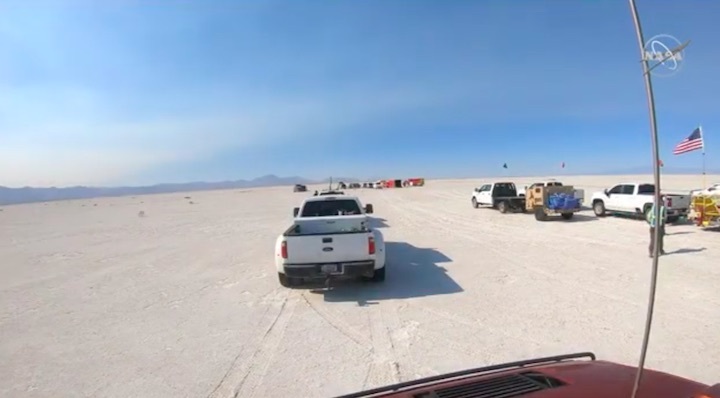
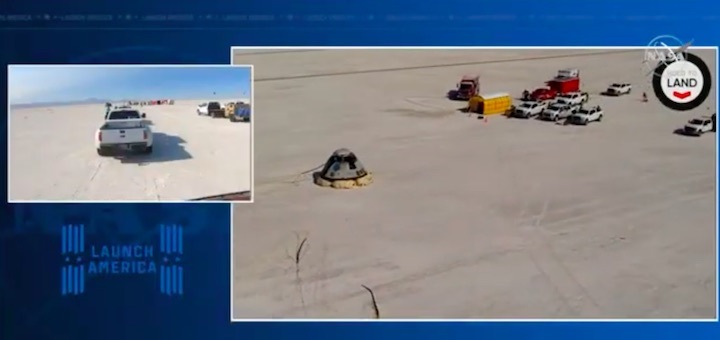
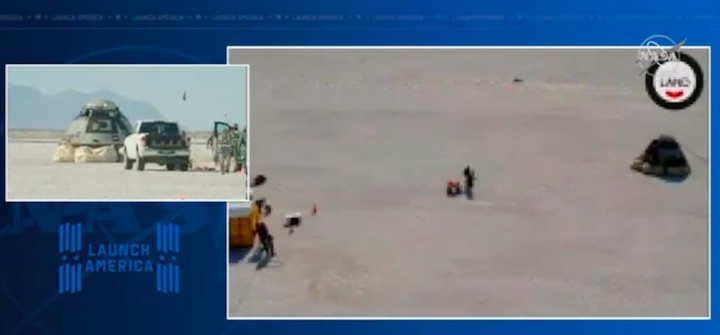
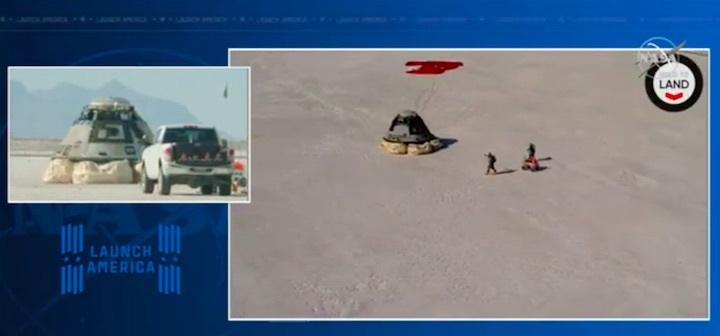
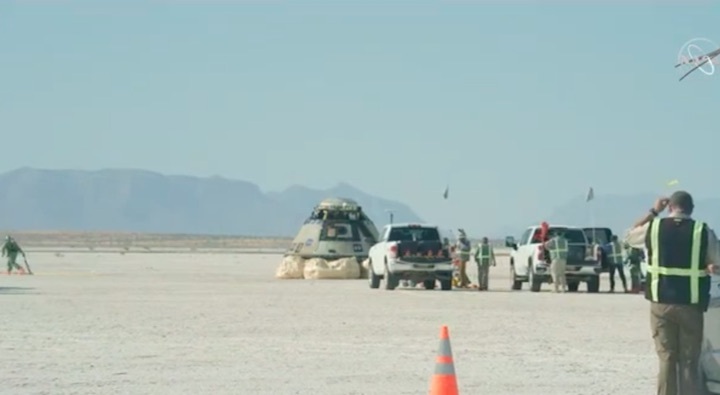
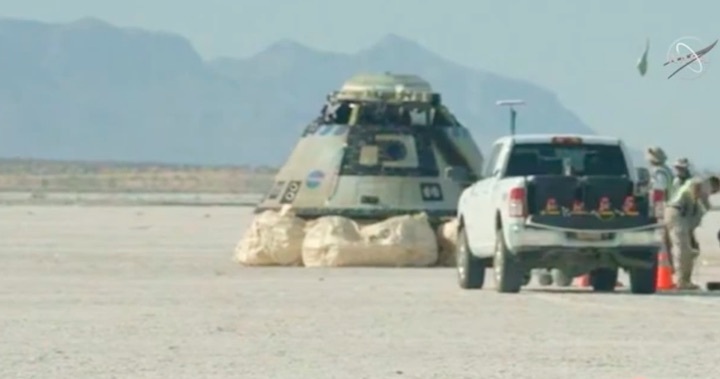
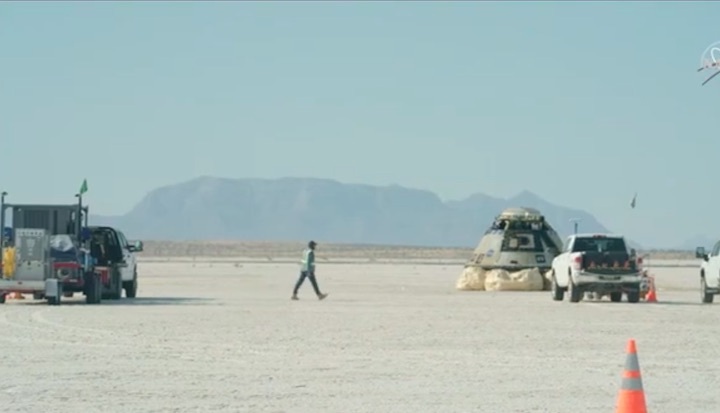
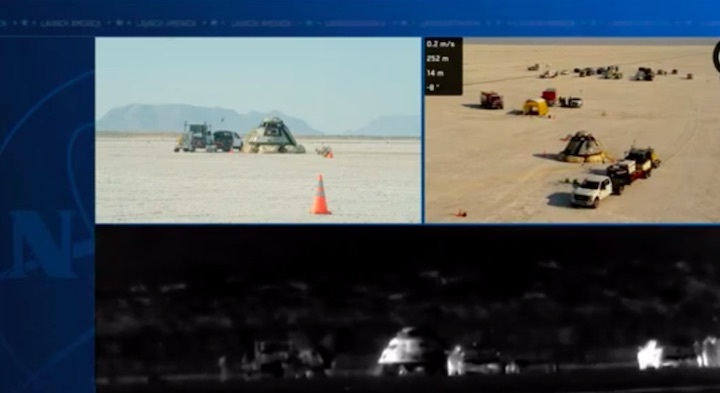
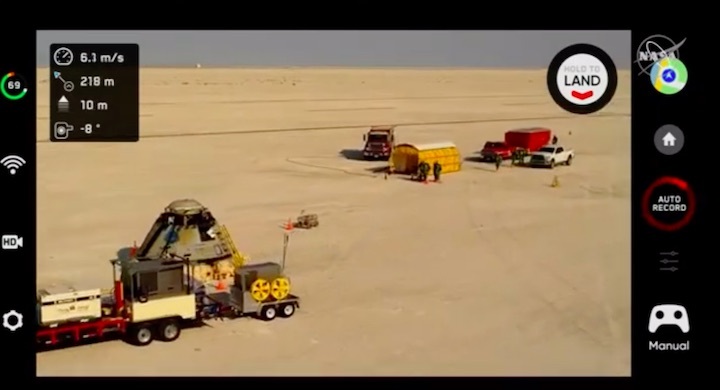
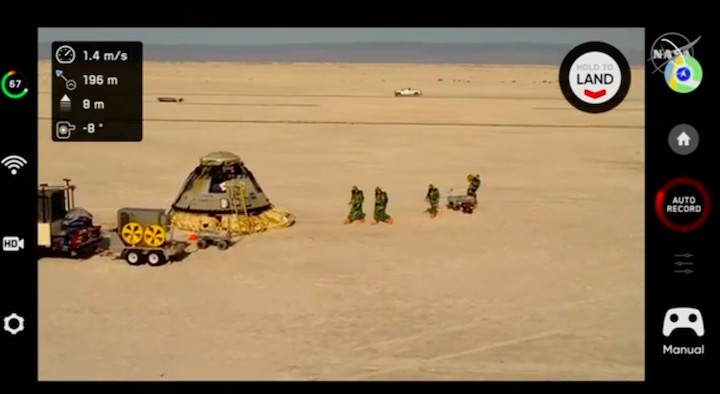
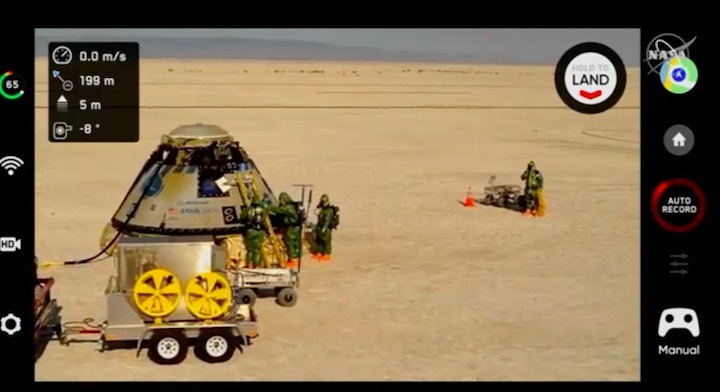
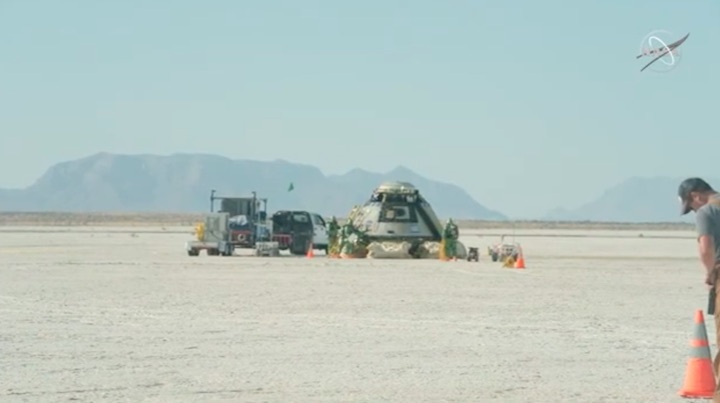
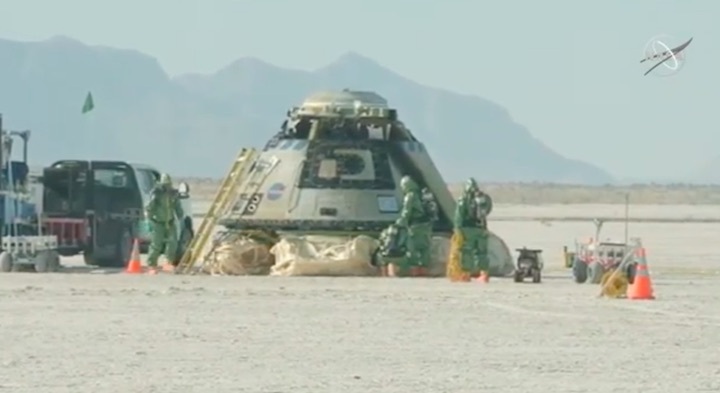
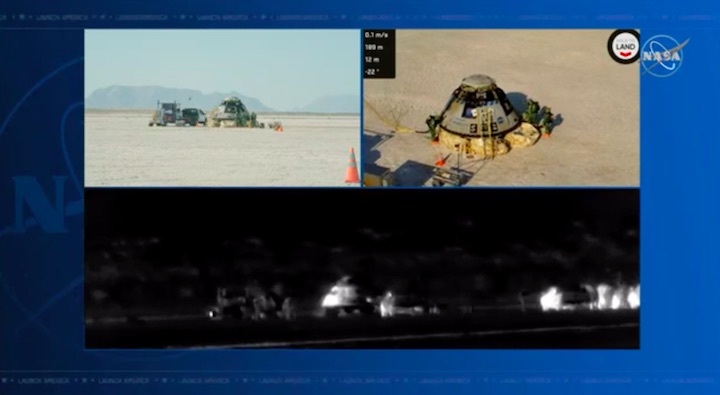
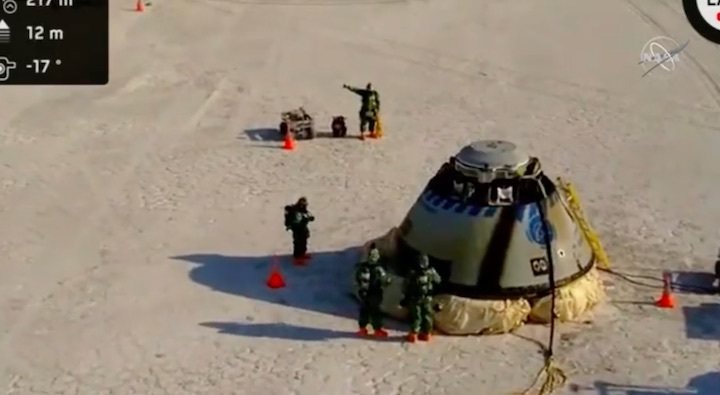
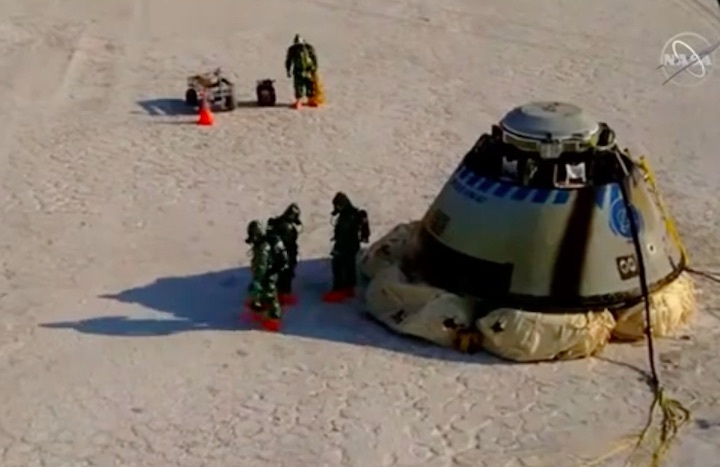
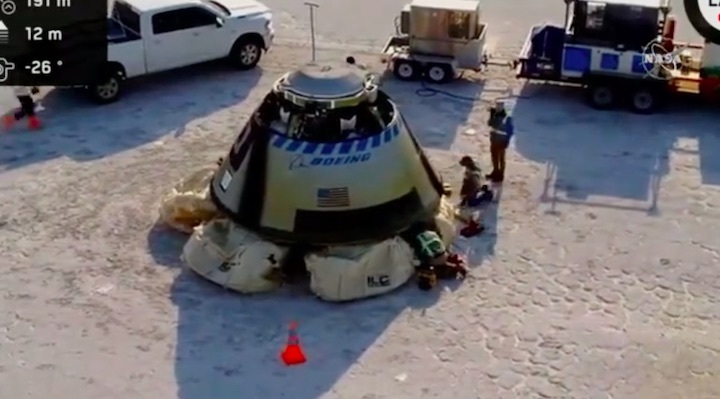
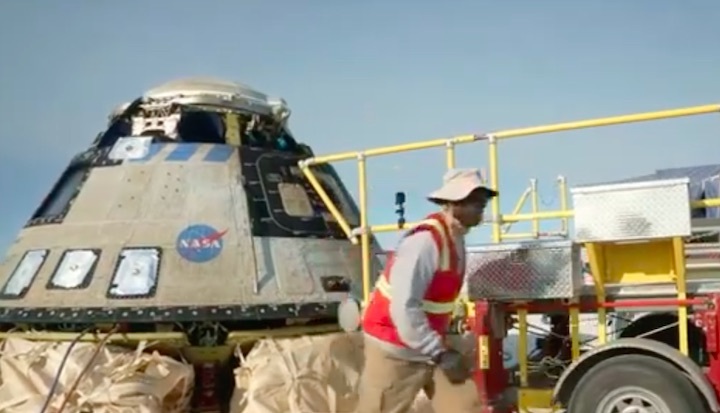
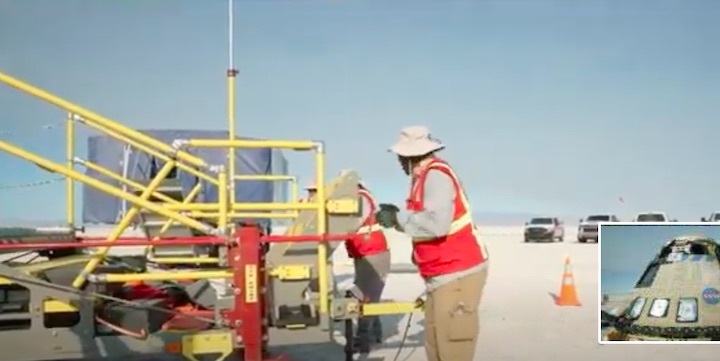
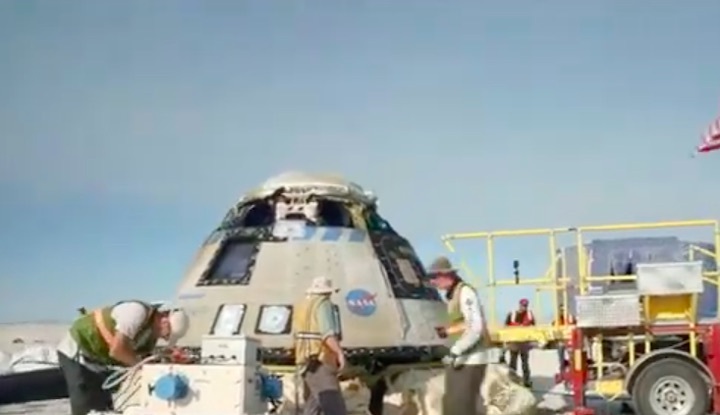
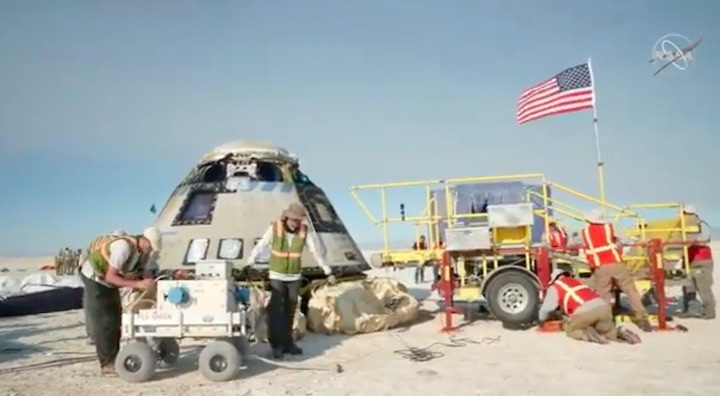
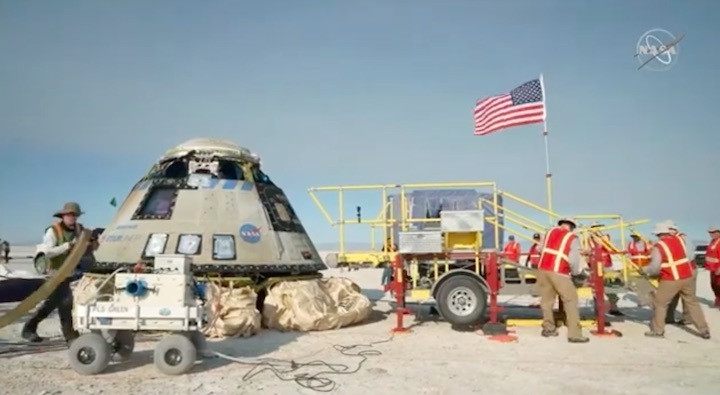
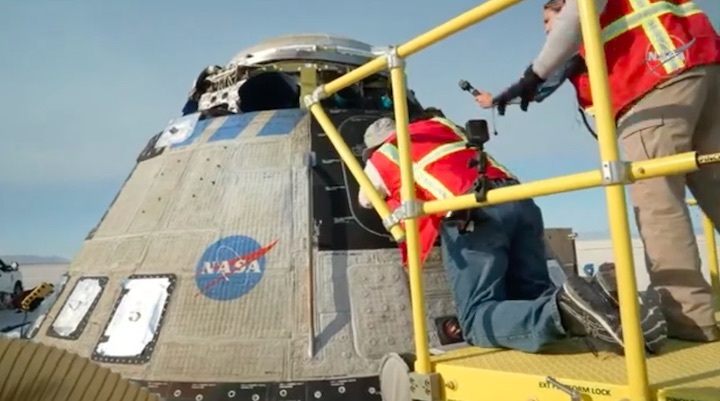
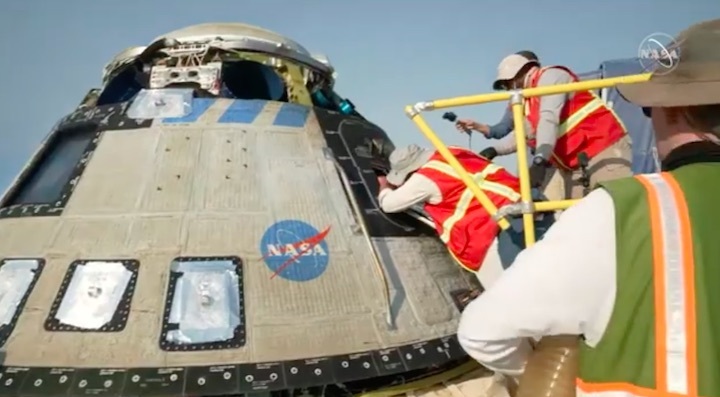
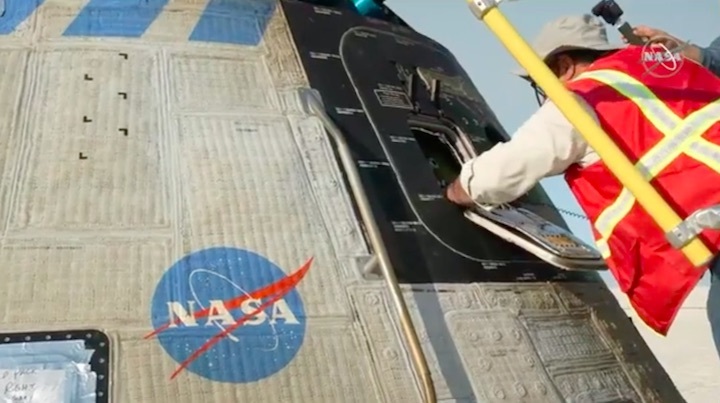
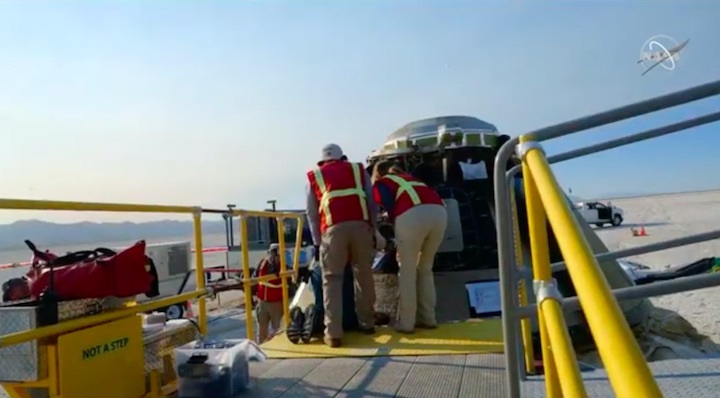
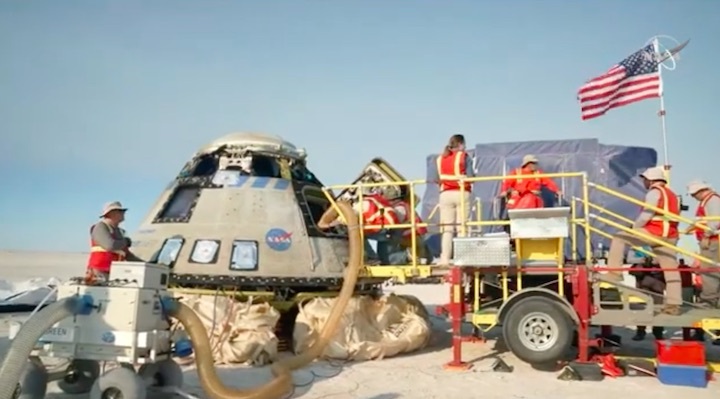
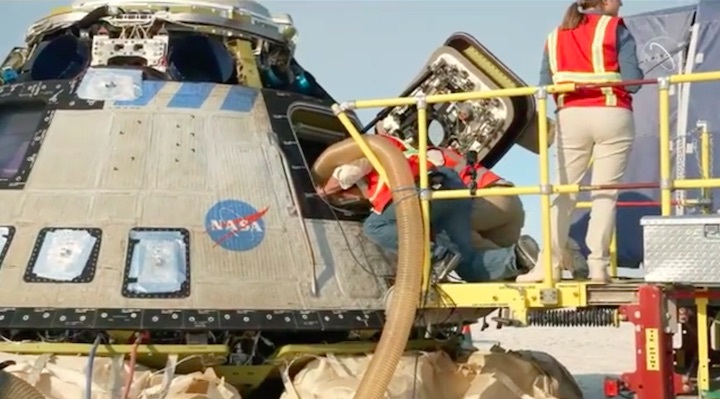
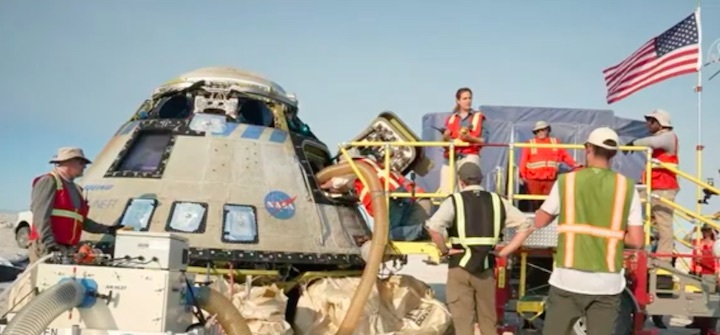 Quelle: NASA +++
Quelle: NASA +++
NASA, Boeing Complete Starliner Uncrewed Flight Test to Space Station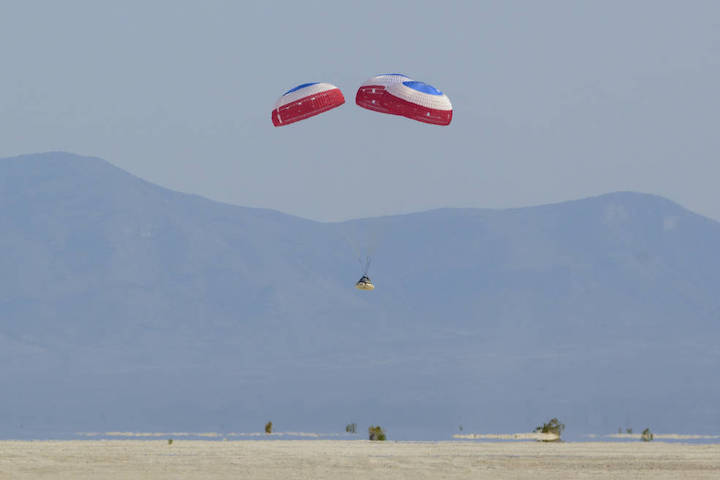
NASA and Boeing safely landed the company’s CST-100 Starliner spacecraft Wednesday in the desert of the western United States, completing the uncrewed Orbital Flight Test-2 (OFT-2) to the International Space Station to help prove the system is ready to fly astronauts.
About four hours after departing the space station, Starliner touched down onto its airbags at 4:49 p.m. MDT, wrapping up the six-day flight, which tested the end-to-end capabilities of the crew-capable spacecraft. The landing followed a deorbit burn at 4:05 p.m., separation of the spacecraft’s service module, and successful deployment of its three main parachutes and six airbags.
“NASA’s Commercial Crew Program and our industry partner, Boeing, today took a major and successful step on the journey to enabling more human spaceflight missions to the International Space Station on American spacecraft from American soil,” said NASA Administrator Bill Nelson. “The OFT-2 mission represents the power of collaboration, which allows us to innovate for the benefit of humanity and inspire the world through discovery. This golden era of spaceflight wouldn’t be possible without the thousands of individuals who persevered and poured their passion into this great achievement.”
As part of the flight test for NASA’s Commercial Crew Program, Boeing accomplished planned test objectives, including:
- Starliner launch and normal trajectory to orbital insertion
- Launch of United Launch Alliance’s (ULA) Atlas V and dual-engine Centaur second stage
- Ascent abort emergency detection system validation
- Starliner separation from the Atlas V rocket
- Approach, rendezvous, and docking with International Space Station
- Starliner hatch opening and closing, astronaut ingress, and quiescent mode
- Crew habitability and internal interface evaluation
- Starliner undocking and departure from space station
- Starliner deorbit, and crew module separation from service module
- Starliner descent and atmospheric entry with aero-deceleration system
- Precision targeted landing and recovery
“I am incredibly proud of the dedication and perseverance shown by the NASA, Boeing and ULA team culminating in the successful completion of Starliner’s second Orbital Flight Test from start to finish,” said Steve Stich, manager, NASA’s Commercial Crew Program. “Throughout this process, Starliner has provided a tremendous amount of valuable data, which we’re continuing to assess in our effort to bring the spacecraft online and fully operational for crew flights to the space station as soon as it is safe to do so.”
The flight test began Thursday, May 19, when Starliner launched on the ULA Atlas V rocket from Space Launch Complex-41 at Cape Canaveral Space Force Station in Florida.
Following liftoff, Starliner successfully entered Earth’s orbit, performed a series of demonstrations of its capabilities, and docked with the orbital outpost 26 hours after launch. The Expedition 67 crew aboard the station opened hatches and entered the capsule for the first time, inspecting the spacecraft and verifying integration with power and communications station systems for longer stays in the future. The station crew also unloaded 500 pounds of cargo delivered by Starliner and sent 600 pounds of cargo back to Earth.
“Congratulations to the NASA and Boeing teams,” said Joel Montalbano, manager of NASA’s International Space Station Program. “I am excited to see the completion of a critical step in bringing another system online to transport long-duration crew members to and from the International Space Station. Soon, we hope to see crews arrive to the space station on Starliner to continue the important microgravity scientific research and discovery made possible by the orbiting laboratory.”
A critical step in validating the performance of Boeing’s systems, OFT-2 brings the nation a significant step closer to having two unique human transportation systems to carry astronauts to and from the space station from U.S. soil.
“We have had an excellent flight test of a complex system that we expected to learn from along the way and we have,” said Mark Nappi, vice president and program manager, Boeing Commercial Crew Program. “With the completion of OFT-2, we will incorporate lessons learned and continue working to prepare for the crewed flight test and NASA certification. Thank you to the NASA and Boeing teammates who have put so much of themselves into Starliner.”
Starliner carried a “passenger” on this flight test – a lifelike test device named Rosie.
During OFT-1, Rosie was outfitted with 15 sensors to collect data on what astronauts will experience during flights on Starliner. For OFT-2, spacecraft data capture ports previously connected to Rosie’s 15 sensors were used to collect data from sensors placed along the seat pallet, which is the infrastructure that holds all the crew seats in place. Among the cargo returned were three Nitrogen Oxygen Recharge System reusable tanks that provide breathable air to station crew members. The tanks will be refurbished on Earth and sent back to station on a future flight.
Boeing retrieved the spacecraft from the desert and will transport it back to the company’s Commercial Crew and Cargo Processing Facility at NASA’s Kennedy Space Center in Florida for processing.
After NASA and Boeing review processes data from this test flight, teams will continue plans for Starliner and its next mission, the Crew Flight Test to the space station. Quelle: NASA

